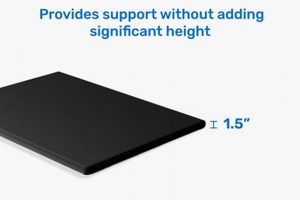A sleeping surface that offers insufficient give or contouring to the body is often described as excessively rigid. This characteristic can result in pressure points, particularly at the shoulders, hips, and knees. For instance, individuals may experience discomfort when lying on their side because of the concentrated pressure on bony prominences.
The level of compliance in a sleep surface is important for spinal alignment and overall sleep quality. Historically, firmer surfaces were recommended for back pain, but contemporary research suggests that a balance between support and comfort is optimal. A surface lacking sufficient cushioning may prevent muscles from fully relaxing, leading to restlessness and disrupted sleep cycles. Proper pressure relief is essential for promoting healthy circulation and minimizing tossing and turning throughout the night.
Understanding the implications of a sleep surface with inadequate softness is crucial when considering factors such as sleep position, body weight, and individual comfort preferences. The subsequent sections will delve into identifying the signs of discomfort, exploring potential solutions, and addressing specific concerns related to this sleep environment.
Addressing Excessive Mattress Firmness
The following recommendations offer potential remedies for improving comfort and mitigating the adverse effects associated with an unyielding sleep surface.
Tip 1: Employ a Mattress Topper. A topper, constructed from materials such as memory foam, latex, or down alternative, introduces a layer of cushioning between the sleeper and the support core. The thickness and density of the topper should be selected based on the individual’s body weight and preferred sleep position.
Tip 2: Rotate the Mattress Regularly. Consistent rotation can help distribute wear evenly across the surface, preventing localized depressions or hardening. Rotating the mattress every three to six months is generally recommended.
Tip 3: Introduce a Mattress Pad. A padded layer, thinner than a topper, may provide a subtle degree of additional comfort. While not as substantial as a topper, a mattress pad can help to mitigate minor pressure points.
Tip 4: Consider a Slatted Bed Frame. A slatted frame offers a degree of flex and give compared to a solid platform. The flexibility of the slats can contribute to a slightly softer feel.
Tip 5: Allow Time for Adjustment. A newly acquired mattress may require a break-in period. Extended use can gradually soften the materials, improving conformity over time.
Tip 6: Evaluate the Foundation. An unsuitable or damaged foundation can exacerbate the feeling of excessive firmness. Ensure the foundation provides adequate support and is appropriate for the mattress type.
Implementing these strategies can enhance comfort and promote a more restful sleep experience when faced with an overly firm sleep surface.
These suggestions offer immediate relief, but it is also advisable to explore the ideal sleeping surface for long-term well-being. Further sections of this article address these concerns.
1. Pressure Points
Excessive rigidity in a sleep surface significantly contributes to the formation of pressure points. These localized areas of concentrated force, arising from insufficient contouring, impede circulation and disrupt sleep patterns. The interaction between the body and an unyielding surface necessitates a detailed examination.
- Formation Mechanisms
Pressure point formation occurs when the skeletal prominences of the body, such as the hips, shoulders, and knees, bear a disproportionate amount of weight on the sleep surface. Inadequate cushioning fails to distribute weight evenly, leading to concentrated pressure in these specific areas. This compression restricts blood flow to the surrounding tissues.
- Physiological Consequences
Prolonged exposure to pressure points can induce discomfort, pain, and numbness. Restricted blood flow to the affected area can lead to tissue ischemia, potentially causing tingling sensations or sharp pain. These physical discomforts frequently disrupt sleep, leading to fragmented sleep cycles and daytime fatigue.
- Impact on Sleep Posture
Individuals experiencing pressure point discomfort often shift their sleeping position to alleviate the localized pressure. This constant repositioning disrupts the natural sleep cycle, preventing the attainment of deep, restorative sleep stages. Frequent postural changes can also strain muscles and joints, exacerbating overall discomfort.
- Influence of Body Weight and Sleep Position
Body weight and sleep position significantly influence the severity of pressure point formation. Individuals with higher body mass experience greater pressure on the sleeping surface. Similarly, side sleepers are more susceptible to pressure points at the shoulders and hips due to the concentrated weight distribution in these areas.
The presence of pressure points, exacerbated by an overly rigid sleeping surface, necessitates interventions aimed at improving weight distribution and reducing localized pressure. Effective mitigation strategies involve the use of mattress toppers, adjusting sleep positions, and selecting a sleep surface with improved contouring capabilities. A direct correlation exists between surface compliance and the minimization of these detrimental pressure concentrations.
2. Spinal Alignment
Proper spinal alignment during sleep is crucial for musculoskeletal health and overall well-being. When a sleep surface lacks adequate compliance, it can impede the natural curvature of the spine, resulting in discomfort and potential long-term postural issues. The connection between an unyielding mattress and spinal health is directly linked to the body’s ability to maintain its neutral position throughout the night. For instance, a side sleeper on an excessively rigid surface may experience lateral spinal flexion, straining supporting ligaments and muscles. Conversely, a back sleeper may find that the lumbar region receives insufficient support, leading to hyperextension and lower back pain.
Maintaining the natural spinal curves is essential for minimizing stress on vertebral discs and associated structures. An inappropriately firm mattress can force the body to conform to its unyielding surface, rather than allowing the surface to conform to the body’s contours. This misalignment can lead to uneven weight distribution, exacerbating pressure on specific spinal regions. Individuals who consistently sleep on a surface lacking adequate give may develop chronic back pain, stiffness, and reduced mobility. Selecting an appropriately compliant mattress is therefore an investment in long-term spinal health, facilitating restful sleep and minimizing musculoskeletal strain
.
In summary, the relationship between a sleep surface and spinal alignment is a key determinant of sleep quality and physical health. An overly rigid mattress can disrupt natural spinal curvature, leading to discomfort, pain, and potential long-term musculoskeletal issues. Prioritizing appropriate surface compliance and assessing individual needs is essential for ensuring proper spinal support and promoting optimal sleep posture. A balanced approach, considering both support and contouring, is crucial for achieving a healthy and restful sleep experience, ultimately promoting spinal well-being.
3. Circulation Issues
Excessive sleep surface rigidity can impede adequate blood flow, particularly in peripheral tissues. Prolonged compression of capillaries and small blood vessels, arising from concentrated pressure, may lead to compromised circulation. For example, an individual lying on their side may experience reduced blood flow to the dependent shoulder and hip, potentially causing numbness, tingling, or discomfort. These circulatory disturbances disrupt sleep and may contribute to long-term health concerns.
The relationship between sleep surface firmness and circulation is directly linked to the body’s ability to maintain proper tissue perfusion during sleep. When a sleeping surface lacks sufficient give, it prevents uniform weight distribution, increasing the likelihood of localized pressure. This sustained pressure inhibits the normal exchange of oxygen and nutrients at the cellular level. Individuals with pre-existing circulatory conditions, such as peripheral artery disease or diabetes, may be particularly vulnerable to the adverse effects of an unyielding sleep surface. Therefore, consideration of circulatory implications is essential when selecting a mattress.
In summary, an overly rigid sleep surface can significantly impact circulation, leading to discomfort, sleep disruption, and potential long-term health consequences. Understanding the connection between surface compliance and vascular health is crucial for promoting restful sleep and minimizing the risk of circulatory compromise. Individuals with circulatory concerns should prioritize mattress selection, opting for surfaces that provide adequate support while minimizing localized pressure and ensuring optimal tissue perfusion.
4. Muscle Tension
An excessively rigid sleep surface contributes significantly to muscle tension. When the body lies on a surface that fails to conform to its natural contours, muscles must engage to compensate for the lack of support and maintain spinal alignment. This constant muscular effort results in sustained tension, hindering relaxation and impeding restorative sleep processes. For instance, an individual with broad shoulders may find that their trapezius muscles remain contracted throughout the night as the surface does not allow the shoulder to sink in, leading to morning stiffness and pain. The absence of adequate pressure relief forces muscles to work overtime, thereby interrupting the natural cycle of muscle relaxation during sleep.
Prolonged muscle tension, stemming from an unsuitable sleep environment, can manifest in various symptoms, including headaches, neck pain, and lower back discomfort. The persistent strain on musculature may also exacerbate pre-existing musculoskeletal conditions. Practical understanding of this connection underscores the importance of selecting a sleep surface that provides balanced support and conformity. Individuals experiencing chronic muscle tension should assess their sleeping surface to determine whether it contributes to their symptoms. Implementing adjustments, such as adding a mattress topper or replacing the mattress, can alleviate muscular strain and promote more restful sleep.
In summary, the relationship between an overly firm mattress and muscle tension is a crucial consideration for optimizing sleep quality and overall physical comfort. Addressing the issue through appropriate mattress selection and adjustments can mitigate muscle strain, promote relaxation, and contribute to improved well-being. Recognizing this connection is essential for individuals seeking to alleviate chronic muscle tension and improve their sleep environment. The ability of a mattress to contour to the body and reduce areas of high pressure is paramount to ensuring proper muscular relaxation during sleep.
5. Sleep Disruption
A sleep surface that provides inadequate cushioning or support often leads to fragmented sleep patterns. The discomfort induced by excessive firmness necessitates frequent postural adjustments, thereby disrupting the natural progression through sleep stages and compromising overall sleep quality.
- Frequent Arousal
An overly rigid mattress can induce frequent awakenings throughout the night. Discomfort from pressure points, inadequate spinal alignment, or muscular strain triggers arousal mechanisms, disrupting sleep continuity. These arousals may be brief, often unnoticed by the individual, but collectively degrade sleep quality and reduce the time spent in deeper, more restorative sleep stages. For example, a person may unconsciously shift position multiple times an hour, each movement constituting a brief interruption in the sleep cycle.
- Reduced REM Sleep
Rapid Eye Movement (REM) sleep, characterized by increased brain activity and dreaming, is essential for cognitive function and emotional regulation. An uncomfortable sleep surface can reduce the amount of time spent in REM sleep. Frequent arousals and discomfort may prevent the attainment of the deeper sleep stages necessary for REM to occur. Reduced REM sleep may manifest as impaired memory consolidation, difficulty concentrating, and mood disturbances.
- Increased Sleep Latency
Sleep latency, the time it takes to fall asleep, can be prolonged by an overly firm mattress. Discomfort and the inability to find a comfortable position may lead to increased restlessness and difficulty initiating sleep. Individuals may spend an extended period tossing and turning, attempting to alleviate pressure points and achieve a state of relaxation conducive to sleep onset. This prolonged sleep latency can contribute to sleep deprivation and daytime fatigue.
- Decreased Sleep Efficiency
Sleep efficiency, the ratio of time spent asleep to time spent in bed, is a key indicator of sleep quality. Excessive firmness, by causing frequent arousals, increasing sleep latency, and reducing time spent in deeper sleep stages, diminishes sleep efficiency. As a result, individuals may spend a significant portion of their time in bed awake, leading to a reduced overall sleep duration and a diminished sense of restfulness.
The disruption of sleep caused by excessive sleep surface rigidity underscores the importance of selecting a mattress that provides adequate support and comfort. Mitigating the factors that contribute to sleep fragmentation is crucial for promoting restorative sleep and maintaining overall health and well-being. An assessment of individual needs and preferences, followed by the selection of an appropriately compliant mattress, can significantly improve sleep quality and reduce the
incidence of sleep disruption.
6. Material Composition
The perceived rigidity of a sleep surface is directly influenced by its constituent materials and their arrangement. A sleep surface primarily composed of high-density materials with limited compression characteristics tends to present as overly firm. For instance, a mattress constructed with a thick layer of firm innerspring coils and only a thin comfort layer of low-density foam will invariably exhibit a substantial degree of unyieldingness. Conversely, a sleep surface utilizing a thicker layer of conforming materials, such as memory foam or latex, will offer a more compliant and less rigid feel. The type and density of the materials used, along with their relative proportions, determine the overall surface feel and its potential to create localized pressure points.
The underlying support core of the mattress also plays a critical role in determining its firmness. A support system utilizing tightly packed, low-gauge steel coils will generally provide a firmer base than a system employing individually wrapped coils with a higher gauge. Similarly, the density and composition of the foundational foam layers influence the degree of sinkage and contouring provided. Hybrid mattresses, which combine innerspring or coil systems with layers of memory foam or latex, attempt to strike a balance between support and comfort. However, if the comfort layers are insufficient or composed of excessively dense materials, the mattress may still be perceived as too rigid. The inherent properties of each material used in construction contribute additively to the overall feel, and their effective integration is essential for optimizing sleep surface comfort.
Ultimately, understanding the interplay between material composition and sleep surface firmness is crucial for making informed purchasing decisions. The selection of materials significantly dictates the mattress’s capacity to conform to the body, alleviate pressure points, and promote proper spinal alignment. Individuals seeking to avoid an overly rigid sleep surface should carefully consider the materials used in both the comfort layers and the support core, prioritizing options that offer a balance of support and contouring. Therefore, assessing material specifications and construction details represents a necessary step in choosing a mattress that aligns with individual comfort preferences and promotes restful sleep.
Frequently Asked Questions
This section addresses common inquiries regarding the implications and potential solutions related to an overly firm sleep surface.
Question 1: What are the primary indicators that a mattress is excessively rigid?
Indications include persistent pressure points, particularly in the hips, shoulders, and knees; morning stiffness or pain; frequent tossing and turning throughout the night; and a general feeling of discomfort preventing restful sleep.
Question 2: Can an overly firm mattress cause long-term health problems?
While not directly causative of disease, prolonged use of an excessively rigid mattress can contribute to chronic pain, musculoskeletal issues, and sleep deprivation, potentially exacerbating existing health conditions.
Question 3: Is it possible to soften an overly firm mattress without purchasing a new one?
Yes, employing a mattress topper, rotating the mattress regularly, and ensuring the foundation provides adequate give are potential methods for mitigating excessive firmness.
Question 4: Are there specific mattress materials or constructions that are inherently more prone to being excessively rigid?
Mattresses with high-density foam, minimal comfort layers, and tightly packed innerspring coils are generally more likely to exhibit excessive firmness.
Question 5: Does body weight influence the perception of mattress firmness?
Yes, individuals with higher body weights may perceive a mattress as less firm compared to individuals with lower body weights, due to increased compression of the materials.
Question 6: How does sleep position factor into the appropriateness of mattress firmness?
Side sleepers typically require a softer surface to accommodate shoulder and hip contouring, while back sleepers may prefer a slightly firmer surface for spinal support. Stomach sleepers often benefit from a firmer surface to prevent excessive sinkage.
In summary, addressing concerns related to sleep surface rigidity requires careful consideration of individual needs, sleep preferences, and potential health implications. Assessing these factors and implementing appropriate solutions can promote more restful and restorative sleep.
The following sections will delve into further specifics concerning the long term effects of an overly firm mattress.
Mattress Too Firm
The preceding analysis clarifies the multifaceted implications of a sleep surface exhibiting excessive rigidity. From the formation of pressure points and compromised spinal alignment to circulatory impediments, muscular strain, and disrupted sleep patterns, the consequences of inadequate cushioning are substantial. Material composition and individual factors such as body weight and sleep position further contribute to the overall perception and impact of an unyielding sleep environment. Understanding these interconnected elements is essential for informed decision-making and the optimization of sleep quality.
Addressing concerns related to an excessively rigid mattress necessitates a proactive approach. By carefully evaluating personal needs, implementing corrective measures such as mattress toppers, and considering the long-term implications of sleep surface selection, individuals can take definitive steps to enhance their sleep environment and promote lasting well-being. Continued awareness and informed choices are vital for mitigating the potential adverse effects associated with an unsuitable mattress. Prioritizing sleep health through conscientious product selection contributes significantly to overall quality of life.





![Bayonne Mattress Firm: Sleep Better Locally [Deals] Organic & Natural Mattress Buyer’s Guide: Non-Toxic Sleep Solutions Bayonne Mattress Firm: Sleep Better Locally [Deals] | Organic & Natural Mattress Buyer’s Guide: Non-Toxic Sleep Solutions](https://mattressworldpa.com/wp-content/uploads/2025/07/th-9086-300x200.jpg)

